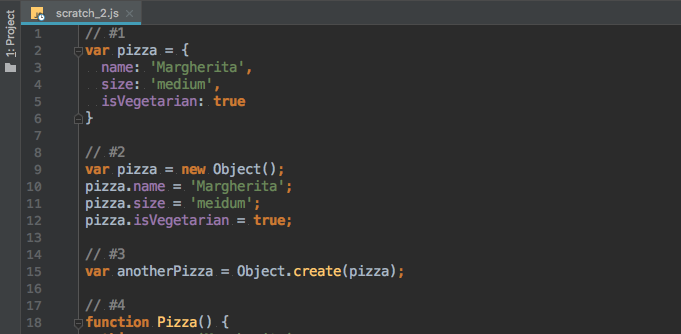Table of contents
- Object literal notation
- The "new()" keyword
- The Object.create(...) method
- Constructor function
- The object.assign(...) method
- The JSON.parse(JSON.stringify(object)) method
Object literal notation
var pizza = {
name: 'Margherita',
size: 'medium',
isVegetarian: true
}This is the most common and popular way of creating an object and used to save data in a structured way. Always refers to the prototype of the main Object.
The "new()" keyword
var pizza = new Object();
pizza.name = 'Margherita';
pizza.size = 'meidum';
pizza.isVegetarian = true;This approach produces the same outcome as a previous mechanism (refers to main Object's prototype) but has different syntax. Less popular since requires more typing :-)
The Object.create(...) method
Unlike the first two examples, the purpose of create method is to
create a new object with specific prototype. In the
first two cases the prototype of the main object was used, but in this
case, we should pass an object into create() which will be
considered as a prototype.
var pizza = {
name: 'Margherita',
size: 'medium',
isVegetarian: true
}
var anotherPizza = Object.create(pizza);
/*
console.log(anotherPizza)
{
name: 'Margherita',
size: 'medium',
isVegetarian: true
}
*/In this example, anotherPizza will not have all default
methods and fields that come from the default main Object.
It will only have methods and fields that came from pizza
object as it was passed as an anotherPizza's prototype.
Constructor function
function Pizza() {
this.name = 'Margherita',
this.size = 'medium',
this.isVegetarian = true
}
var pizza = new Pizza();By using this approach we created a new object which also has its own
prototype. However, compared to point 3, in the current example
pizza will have fields and methods from Pizza
plus all methods and fields from the main Object since
Pizza's prototype' was inherited from the
mainObject's prototype.
This way is useful when it's necessary to create multiple objects with the same base functionality.
The object.assign(...) method
var pizza = Object.create({
name: 'Margherita',
size: 'medium',
isVegetarian: true
});Even though syntactically it's completely right, using
assign() it this way is not common.
However, it's extremely helpful when it's necessary to create a new object with a new reference in memory based on the existing one:
var anotherPizza = Object.assign(pizza, {
name: 'Capricciosa',
isVegetarian: false
})In addition to that, Object.assign() produces a new
object in an immutable way (doesn't modify the old one in a case it will
be changed).
Sidenote: If it's not clear why doing
var anotherPizza = pizza;is a bad idea, you need to read more about reference types (in javascript all objects are reference types).
The JSON.parse(JSON.stringify(object)) method
var pizza = {
name: 'Margherita',
size: 'medium',
isVegetarian: true
}
var anotherPizza = JSON.parse(JSON.stringify(pizza));Even though it sounds like a hack, this method is very popular and useful when dealing with copying/cloning objects with deep structure. The same as the previous example, it does create a completely new object in an immutable way.
The reason it exists is that it's the only one method available out
of the box that can do deep clone/copy. As a sidetone
object.assign is not good at it.
